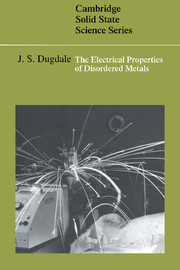Book contents
- Frontmatter
- Contents
- Preface
- 1 Context and content
- 2 Production and structure of metallic glasses
- 3 Electron transport in metals: introduction to conventional theory
- 4 Scattering
- 5 Simple liquid metals: Ziman theory
- 6 Phonons in disordered systems
- 7 Interactions and quasi-particles
- 8 Transition metals and alloys
- 9 The Hall coefficient of metallic glasses
- 10 Magnetoresistance
- 11 Electrical conductivity of metallic glasses: weak localisation
- 12 The interaction effect or Coulomb anomaly
- 13 The effect of the Coulomb interaction on conductivity
- 14 Influence of a magnetic field on the enhanced interaction effect
- 15 The thermopower of metals and alloys
- 16 Comparison with experiment
- Appendices
- Notes
- References
- Index
15 - The thermopower of metals and alloys
Published online by Cambridge University Press: 21 January 2010
- Frontmatter
- Contents
- Preface
- 1 Context and content
- 2 Production and structure of metallic glasses
- 3 Electron transport in metals: introduction to conventional theory
- 4 Scattering
- 5 Simple liquid metals: Ziman theory
- 6 Phonons in disordered systems
- 7 Interactions and quasi-particles
- 8 Transition metals and alloys
- 9 The Hall coefficient of metallic glasses
- 10 Magnetoresistance
- 11 Electrical conductivity of metallic glasses: weak localisation
- 12 The interaction effect or Coulomb anomaly
- 13 The effect of the Coulomb interaction on conductivity
- 14 Influence of a magnetic field on the enhanced interaction effect
- 15 The thermopower of metals and alloys
- 16 Comparison with experiment
- Appendices
- Notes
- References
- Index
Summary
Definitions
The origin of the thermoelectric effects is very simple. They arise because an electric current in a conductor carries not only charge but also heat. Consequently when an electric current flows through the junction of one conductor with another, although the charge flow is exactly matched, there is in general a mismatch in the associated heat flow; the difference is made manifest as the Peltier heat. If the current flows through a conductor in which there is a temperature gradient the heat shows up as the Thomson heat which is the heat that must be added to or subtracted from the conductor to maintain the temperature gradient unchanged; the electric current behaves as if it were a fluid with a heat capacity (either positive or negative). The third manifestation of thermoelectricity is the Seebeck effect which is the inverse of the other two. In this a heat current is established by means of a temperature gradient and this produces an electric current. However this cannot be done with a single material since in such a closed circuit the current induced in one part would cancel that in the other. Instead two materials are needed; moreover it is more convenient to measure not the circulating current that results but the emf that arises when the electrical circuit is broken. More explicitly, if conductor A is connected to conductor B at its two ends and the two junctions are maintained at different temperatures, an emf appears in the circuit.
- Type
- Chapter
- Information
- The Electrical Properties of Disordered Metals , pp. 188 - 199Publisher: Cambridge University PressPrint publication year: 1995



